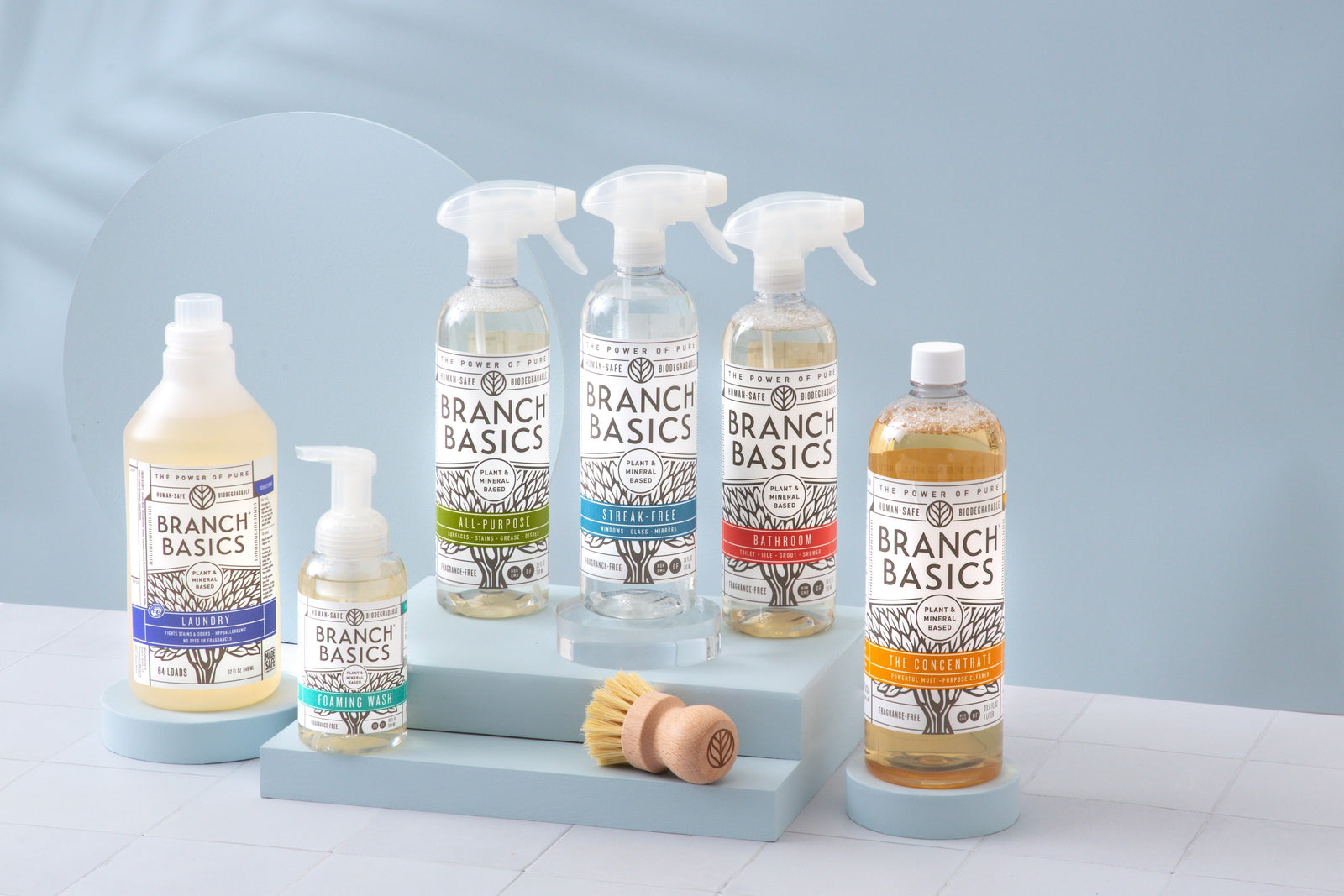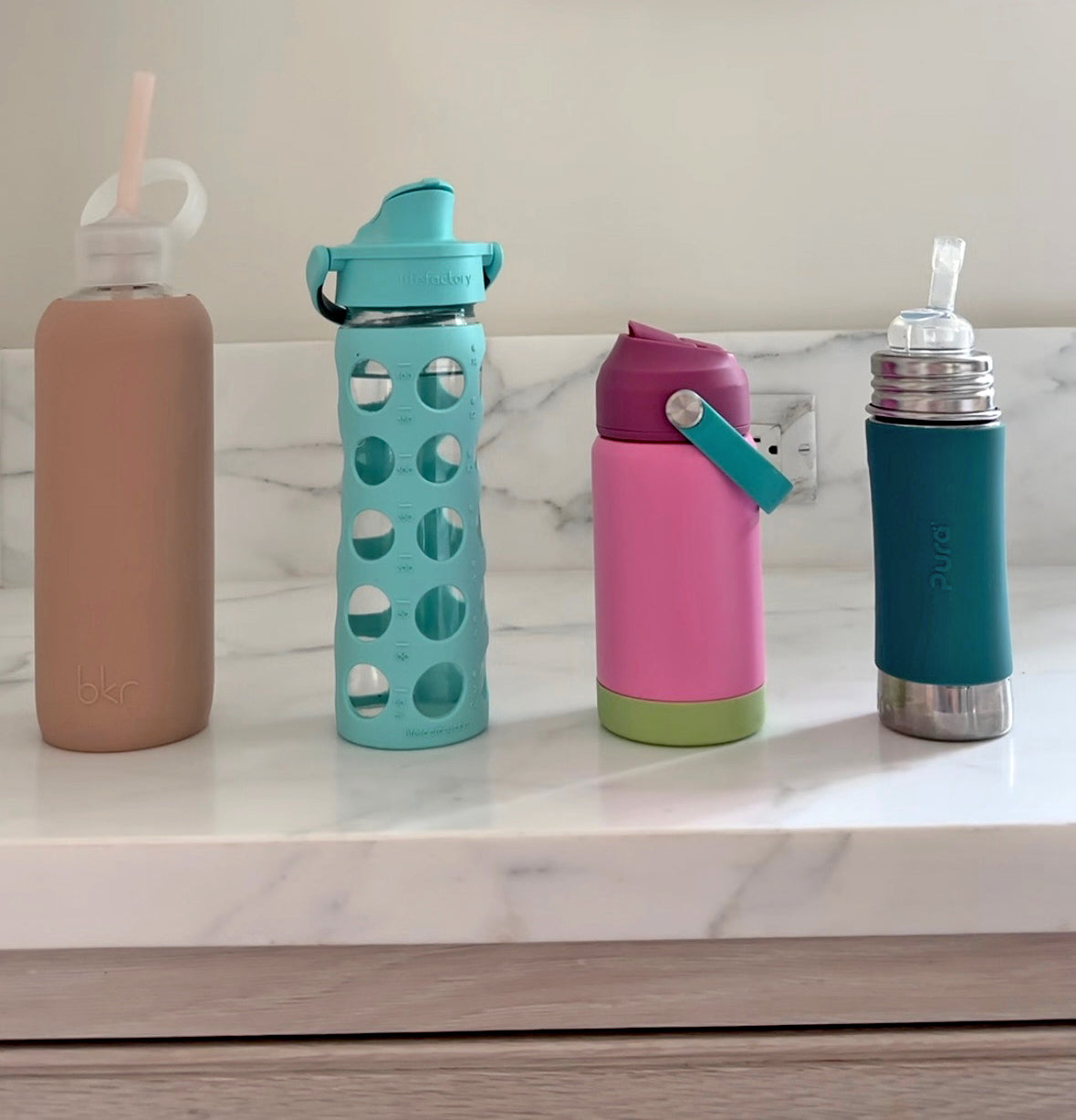Can You Be Allergic or React to Cleaning Products?

Can you be allergic or react to cleaning products? Absolutely!
Everyday chemical-based cleaning and laundry products—and even environmentally-friendly, green, and “natural” varieties—often contain several allergens and potential allergens that can cause all types of reactions, from mild to life-threatening.
This is especially true of scented cleaning products, which contain one of the world’s top allergens: fragrance chemicals.
But fragrance chemicals aren’t the only culprit.
Read on for a detailed account of chemicals in cleaning products that can trigger reactions or allergies, the types of allergic reactions they can cause, and how to choose safer, allergen-free, or low-allergen products for a healthier home.
Chemicals In Cleaning Products That Trigger Allergies
Cleaning products typically contain an extensive list of synthetic chemicals designed to break up dirt and grime, disinfect, degrease, and create a shiny, clean surface.
Laundry products also contain various synthetic ingredients such as detergents, surfactants, bleaches, fragrances, optical brighteners, preservatives, and more.
Many ingredients in these products can cause allergic reactions or sensitivities.
An allergic reaction occurs when the immune system senses an attack and releases an antibody called immunoglobulin E (IgE). This typically triggers various immediate symptoms such as congestion, inflammation, hives, sneezing, wheezing, and even difficulty breathing.
These ingredients can also cause reactions, which, although not as severe as an allergic reaction, can create similar symptoms, plus fatigue, headaches, digestive upset, brain fog, joint pain, emotional distress, and others.
So, how do you know which ingredients are bothering you?
The cleaning and laundry industries use hundreds of chemicals in their products, many of which are not disclosed on labels. Therefore, pinpointing an allergen can be difficult.
However, ample evidence has shown the following seven ingredients can cause an allergic response as well as reactions in adults, children, and pets.
1. VOCs (Volatile Organic Compounds)
VOCs are almost universal in synthetic chemical cleaning products and many green cleaning brands.
VOC stands for volatile organic compounds, and they are found in natural and artificial products.
For example, the smell of a flower is a type of natural VOC, while the scent of bleach or paint is an unnatural or synthetic VOC.
Many synthetic VOCs are harmful, especially if inhaled in large or frequent amounts or if they accumulate in indoor spaces where they cause sick building syndrome.
Research has shown cleaning products are a primary source of VOC pollutants.
For example, a study published in the journal Chemosphere conducted air chamber testing of 28 cleaning products and two air fresheners detected 530 VOCs, of which 193 were considered hazardous!
Based on this one study (and there are more), you can be relatively certain most chemical cleaners contain harmful VOCs.
Per the Environmental Protection Agency, VOC exposure can cause many types of reactions and sensitivities, including:
- Allergic skin reactions
- Brain fog or cognitive impairments
- Damage to the liver, kidneys, and central nervous system
- Dyspnea
- Dizziness
- Eye, nose, and throat irritation
- Headaches
- Loss of coordination
- Nausea
- Nosebleeds
- Respiratory issues, especially for those with asthma or other lung conditions
- Shortness of breath
- Vomiting
Certain VOCs are also suspected or known carcinogens, and long-term effects can include increased risk of asthma, bone marrow disorders, and central nervous system damage.
Synthetic VOC exposure is particularly concerning in pregnant women, the immunocompromised, those with respiratory issues, babies, and small children.
Some common VOCs to watch out for in cleaning products include:
- Chlorine bleach
- Ethylene oxide
- Formaldehyde and formaldehyde donors
- Fragrance
- Glycol esters
Research suggests the greatest concentration of VOCs in cleaning products comes from bleach-based cleaners, glass cleaners, spray cleaners, disinfectants, ammonia-based cleaners, and toilet bowl cleaners.
Scented laundry products, including detergents, fabric softeners, and stain removers, are also a significant source.
Learn more about VOCs in: What Are VOCs And How Do They Affect Your Health?
2. Bleach
Bleach is one of the most common synthetic chemicals in cleaning and laundry products used in homes, workplaces, schools, hotels, venues, and other indoor spaces.
This spells big trouble for anyone with allergies, asthma, chronic illness, or chemical sensitivities (or anyone who cares about avoiding harmful chemicals) because bleach is an allergen, a VOC, and an EPA-registered pesticide.
Bleach fumes create VOCs, like chloroform gas and nitrogen trichloride, which can be highly irritating to the lungs, eyes, nose, throat, and mucous membranes and can cause DNA damage, cancer, asthma, and a host of other illnesses.
It’s also highly corrosive and can cause severe skin burns.
New research has also shown passive exposure to bleach at home can cause an increased risk of respiratory illness and other illnesses in children.
We discuss much more about the toxicity of bleach in: Is Sodium Hypochlorite (Bleach) Toxic?
We have seen incredible results when bleach is removed from people’s homes, including the disappearance of various health issues, allergies, and sensitivities.
Are you wondering how to clean your home and do laundry without bleach?
See 6 Best Cleaning Products Without Bleach for comparable, safe products and DIY recommendations.
3. Ammonia
Ammonia is an extremely common ingredient in cleaning products, from window cleaners to disinfectants. It’s also used in pharmaceuticals, food processing, and industrial agriculture.
Ammonia can be highly hazardous when inhaled or ingested and is a severe skin and eye irritant.
It also creates a deadly gas when combined with chlorine bleach, which can be very dangerous given how often these two ingredients are used together to clean a bathroom, for example.
For all these reasons and more, it is not uncommon to experience an allergic reaction or sensitivity to ammonia-containing products, including:
- Window cleaners
- Floor cleaners
- Tile cleaners
- Multi-purpose cleaners
- Pet stain removers
- Bathroom cleaners
- Disinfect sprays in the form of Quats (quaternary ammonium compounds)
Ammonia exposure via inhalation, skin or eye contact, or ingestion can result in the following reactions or symptoms:
- Blindness and irreparable eye damage
- Bronchiolar and alveolar edema and airway destruction resulting in respiratory distress or failure (death)
- Corrosive damage to the mouth, throat, and stomach
- Coughing, and nose and throat irritation
- Difficulty breathing
- Drooling
- Frostbite injury
- Hives
- Immediate burning of the nose, throat and respiratory tract
- Irritation or damage to the mucous membranes
- Liver, gastrointestinal, and kidney damage
- Rapid skin and eye irritation
- Severe injury and burns to eyes and skin
- Skin rashes
- Wheezing
Regular exposure to low ammonia levels in cleaning products has been proven very harmful to the lungs.
According to research published in the American Journal of Respiratory and Critical Care Medicine, individuals who used ammonia household daily cleaning for 20 years had decreased lung function, equivalent to smoking 20 cigarettes daily!
Babies, young children, the elderly, and people with asthma and immune or respiratory conditions may have a heightened sensitivity to ammonia and ammonia-containing cleaning products.
To learn more about how to avoid ammonia in cleaning products and healthy substitutes, see: 5 Ammonia-Free Cleaning Products.
4. Formaldehyde
Most people are surprised to learn formaldehyde is a common ingredient in cleaning products. After all, it is a known carcinogen!
Specifically, cleaning products use ingredients known as formaldehyde donors or formaldehyde preservatives, which slowly release formaldehyde to inhibit bacterial and pathogen growth.
Formaldehyde exposure can cause a slew of allergic reactions, symptoms, and even death.
It’s a VOC, a carcinogen, a lung irritant, and a universal sensitizer, meaning it can enhance your sensitivity to all chemicals.
Allergic reactions to formaldehyde may include: [Sources 1, 2]
- Anaphylactic reactions
- Asthma
- Dermatitis
- Difficulty breathing
- Eye, skin, and nose irritation
- Fatigue
- Insomnia
- Mental confusion
- Nosebleeds
- Upper respiratory tract irritation and inflammation
- Skin rash
Anyone with asthma or hyper-reactive airways (10-20% of the U.S. population) is especially susceptible to formaldehyde.
The other problem with formaldehyde preservatives in cleaning and personal care products is they are typically not labeled “formaldehyde.”
Here are some of the names used for formaldehyde-based preservatives (aka: formaldehyde donors):
- 2-bromo-2-nitropropane-1,3-diol
- Bromopol
- Diazolidinyl urea
- DMDM Hydantoin
- Imidazolidinyl urea
- Polyoxymethylene urea
- Sodium hydroxymethyl glycinate
- Quaternium-15
Finally, if you live in an area with ozone alerts, beware of using terpene-containing essential oils (pine and citrus). Research has shown that these can mix with ozone and produce formaldehyde on ozone-alert days.
Learn more about how to avoid formaldehyde at home in: 23 Sources of Formaldehyde to Remove from Your Home, Starting Right Now.
5. Sulfuric Acid
Sulfuric acid is an incredibly irritating, highly corrosive, and toxic chemical used in some drain cleaners.
If ingested, it can cause permanent organ damage and even death by literally eating away at your tissues and bones, and the fumes can cause asthmatic attacks, respiratory damage, and extreme eye, nose, and throat irritation.
It’s dangerous stuff that can cause a reaction in nearly anyone and is especially dangerous for babies, toddlers, and young children.
Instead, see Natural Drain Cleaners: 5 Safe Options For Your Home for safer, allergen-free alternatives.
H3: 6. Glycol Esters
Glycol esters, such as ethylene glycol, polyethylene glycol (PEG), 2-butoxyethanol, and glycol ether, are VOCs, surfactants, and solvents used to loosen and trap dirt on surfaces and act as wetting agents in cleaning products.
Glycol esters are found in all-purpose cleaners, window and glass cleaners, laundry products, pharmaceuticals, food products, medical products, and cosmetics.
The most common allergic reactions and hypersensitivity to glycol esters in cleaning products are eye and skin irritation or damage and respiratory symptoms.
However, if ingested, they can cause much more harmful reactions, including anaphylaxis, flushing, dangerous drops in blood pressure, tingling, bronchospasm, and more.
Glycol esters are also reproductive toxins that can affect DNA, making them dangerous for pregnant women and their unborn babies.
7. Fragrance
Fragrance is one of the world’s top allergens. Although it appears harmless, it emits significant VOCs and is used in high concentrations in cleaning products, laundry products, air fresheners, and odor removers.
It’s also one of the most poorly regulated chemical cocktails.
For example, one signature fragrance used in a laundry detergent can contain dozens or hundreds of undisclosed chemicals, many of which are allergens, carcinogens, asthmagens, endocrine-disruptors, neurotoxins and are designated “toxic” or “hazardous.”
Studies conducted on measuring VOCs in cleaning products noted that fragranced products were the worst for emitting the most toxic VOC chemicals.
Fragrance isn’t limited to synthetic chemical cleaning and laundry products either. Many popular eco-friendly or “green” brands include signature chemical fragrances in their formulas.
Unless a product is naturally fragrance-free, you can bet it contains allergenic fragrance chemicals.
Allergic reactions or sensitivity to fragrance chemicals may include:
- Congestion
- Dermatitis, hives, skin rashes
- Dizziness or fainting
- Headaches and migraines
- Gastrointestinal issues
- Neurological effects
- Respiratory problems, including coughing, difficulty breathing, and asthma symptoms
- Watery eyes
Removing synthetic fragrance from your home is a MUST because they are very toxic. If you suffer from asthma, allergies, chemical sensitivity, chronic congestion, hormonal disruption, depression, metabolic dysregulation, headaches, migraines, neurological issues, or chronic illness , the removal of these products from your home is essential to your recovery.
We detail much more about the harmful effects of fragrance in:
- Fragrance Is The New Secondhand Smoke | Eliminate Synthetic Fragrance To Improve Your Health
- The Best Fragrance-Free Cleaning Products And Alternatives
- How To Get Heavy Fragrance Out Of Clothing
What Should You Use Instead?
If you suffer from allergies or sensitivities to cleaning products, human-safe options are the way to go.
That means looking for products free from the ingredients just covered, and ideally have Made Safe Certification and/or have all ingredients rated from “1” to “2” on the Environmental Working Group’s SkinDeep database.
Here are a few of our favorites.
Branch Basics
Branch Basics is a human-safe and natural cleaning line designed for health-conscious, earth-conscious, and chemically-sensitive people.
Our flagship product, Branch Basics Concentrate, contains only gentle, naturally derived ingredients rated a 1-2 on EWG Skin Deep, and is free from fragrance, bleach, formaldehyde, ammonia, glycol esters, petroleum products and contains no known allergens or irritants.
Our ingredients are safe and naturally-derived:
- Decyl Glucoside: This naturally-derived surfactant is COSMOS approved for organic products that comes from non-GMO coconut and/or corn. Its mild nature makes it a popular ingredient in clean skincare and baby products, as well as fruit and veggie sprays, as it will not harm the delicate skin of berries.
- Chamomile Flower Extract: An organic flower extract with Allergen (IFRA) Certifications. This star ingredient is anti-irritant, antiseptic, anti-bacterial, anti-fungal, and anti-inflammatory while nourishing and soothing to the skin.
- Coco Glucoside: This naturally-derived surfactant is COSMOS approved for organic products and comes from coconuts. It is one of the most gentle cleansing agents available, making it suitable for baby and pet products.
- Sodium Citrate: This biodegradable, plant-derived sodium salt acts as a water softener, acidity regulator in food and drinks (think club soda!), and emulsifier.
- Sodium Bicarbonate: Also known as baking soda, this acts as a mineral-based water softener and brightener.
- Sodium Phytate: Phytic acid in plant seeds is often used as a human-safe commercial preservative due to its antioxidant properties.
It’s also Made Safe Certified, never tested on animals, biodegradable, and non-GMO.
And the best part? Branch Basics Concentrate is designed to replace every single cleaning and laundry product in your home—from window cleaner and all-purpose to bathroom cleaner and laundry detergent!
Talk about simplifying safe cleaning.
Check out our Starter Kits to learn more about how the system works.
Baking Soda
Baking soda is non-toxic and incredibly versatile for cleaning, laundry, stain removal, water softening, and more.
It’s also a perfect ingredient to add to DIY cleaning scrubs, is great for rescuing burnt pots and pans, and acts as a natural deodorizer.
Learn more about the power of baking soda in: Cleaning With Baking Soda: 12 Surprising Uses.
Vinegar
Distilled white vinegar is a wonderful, all-purpose cleaner to use for surfaces, glass, mirrors, stainless steel, descaling small appliances, and cleaning produce.
It’s also a powerhouse in the laundry room for softening clothes and removing stains, and has natural sanitizing properties against salmonella, listeria, and E. Coli.
*Note: Note: Vinegar contains acetic acid, a lung irritant when sprayed. Use it in a ventilated area, and hold your breath or donot inhale the freshly sprayed vinegar. Do not spray vinegar in the presence of children, the elderly, and those with lung or chronic health conditions.
Related Read: Home Cleaning Guide For Allergy Sufferers.
Peroxide
3% hydrogen peroxide (in the brown bottle) is an incredible cleaner for surfaces, mirrors, stains, laundry, drains, bathrooms, and more.
It is also an effective, non-toxic disinfectant, especially when used with vinegar (used separately and stored in separate bottles). See How To Naturally Disinfect Surfaces [A Complete Guide] for instructions on how to do this safely.
What makes peroxide non-toxic?
Hydrogen peroxide is made from two elements: two hydrogens and two oxygen (H2O2) molecules, and breaks down as such in our bodies and the environment.
Water is similar. It’s made up of two hydrogen molecules and one oxygen molecule (H2O) and is also a natural substance.
Get more info on how to clean with hydrogen peroxide in: How To Use Hydrogen Peroxide For Non-Toxic Cleaning, Laundry, Disinfecting, & More.
Toss the Toxins With Branch Basics
Replacing toxic, synthetic chemical cleaners with human-safe alternatives is one of the best things you can do to prevent allergic reactions and safeguard your health.
If you’re interested in tossing the toxins, we’d love to help!
Check out Branch Basics Starter Kits, which contain everything you need to replace every single toxic cleaning and laundry product in your home with a safe and healthy alternative.
Premium Starter Kits (available in glass or plastic) contain everything you need including Branch Basics Concentrate, Oxygen Boost (a laundry booster, bleach alternative, and soaking aid), and five bottles to make your own All-Purpose, Bathroom, Streak-Free, Laundry, and Foaming Wash.
Just add the designated amount of Branch Basics Concentrate to the bottle, add water to the fill line, shake, and you’re ready to clean the whole house. It’s as simple as that!
Check out: Is Branch Basics Worth It? for a full breakdown of what makes our cleaning line different, including the cost per bottle of our refillable system.
Categories

Marilee Nelson
Marilee Nelson is an Environmental Toxins expert who has spent nearly 30 years advocating for the chemically-sensitive and chronically-ill. She is a Board Certified Nutritionist, Certified Bau-Biologist and Bau-Biology Inspector and specializes in Food As Medicine. She has helped thousands of families and individuals identify, heal and recover from toxic exposures and is on a mission to revolutionize the way American families view their health.








